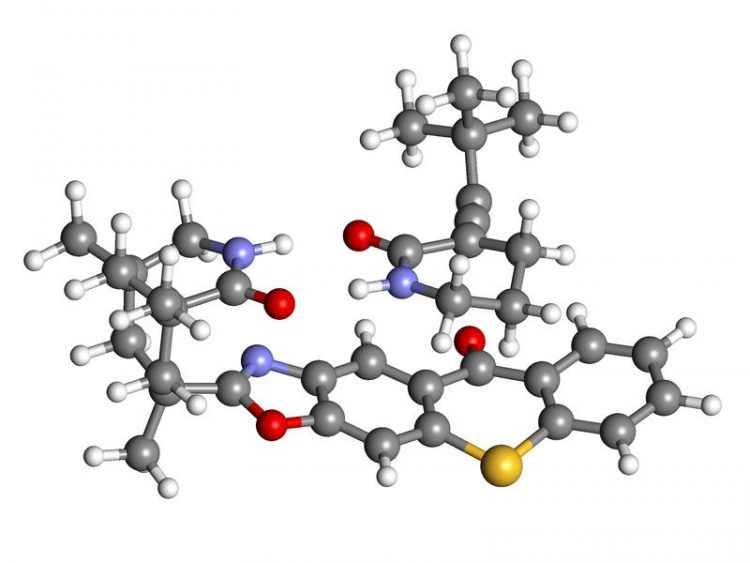Photochemical deracemization of chiral compounds achieved: The vanished mirror image

The allenic group of the unwanted enantiomer is much closer to the thioxanthone sensitizer and is therefore converted to the desired form. Image: S. M. Huber and A. Bauer / TUM
Producing active ingredients with very specific properties – antibacterial characteristics, for example – is not always so easy. The reason: many of these organic compounds are chiral. They have two mirror-image forms, so-called enantiomers.
This small difference can be consequential because the two enantiomers can have different properties. While one has a healing effect, the other might be ineffective or even cause unwanted side effects.
Saving time, energy and resources
“For a long time, researchers around the world have been seeking ways to selectively synthesize only the desired enantiomer from a racemate,” explains Prof. Thorsten Bach, holder of the Chair of Organic Chemistry at the Technical University of Munich. However, this has been very difficult, since chemical reactions usually produce both molecule variants.
Together with his team, the researcher has now developed a method with which the desired enantiomer can be obtained from a racemate, the mixture of both enantiomers, in high concentrations of up to 97 percent.
Rather than painstakingly extracting the unwanted mirror-molecules from the mixture, the researchers use a photochemical reaction to transform them into the desired end product. “That saves time, energy and resources because all the molecules are used and you do not need to throw away half of them,” explains Bach.
A catalyst for the “right” compounds
The secret of the transformation is a special photochemical catalyst. Originally, the thioxanthone sensitizer was developed for [2 + 2] photocycloadditions. The dye is itself chiral and therefore specifically converts only one of the enantiomers to the other. In the span of a few minutes, the equilibrium shifts in favor of the desired molecule. The undesirable mirror images disappear.
The chemists have successfully tested their new method on various molecular mixtures from the allene structural class. “We could thus demonstrate that selective and efficient catalysis to prepare enantiopure compounds from racemates is fundamentally possible,” said Bach.
Further information:
The project was funded by the German Research Foundation (DFG) as part of the Research Training Group GRK 1626, a Reinhart Koselleck project and the Cluster of Excellence RESOLV. Cooperation partners were the universities of Bonn and Bochum.
Prof. Dr. Thorsten Bach
Chair of Organic Chemistry I
Technical University of Munich
Lichtenbergstr. 4, 85748 Garching
Tel. + 49-89-28913330 – E-mail: thorsten.bach@ch.tum.de
Catalytic deracemisation of chiral allenes enabled by sensitised excitation with visible light,
Alena Hölzl-Hobmeier, Andreas Bauer, Alexandre Vieira Silva, Stefan M. Huber, Christoph Bannwarth, Thorsten Bach
Nature, 564, 240–243 (2018) – DOI: 10.1038/s41586-018-0755-1
https://www.nature.com/articles/s41586-018-0755-1
https://www.tum.de/nc/en/about-tum/news/press-releases/detail/article/35146/ Link to the press release
http://www.oc1.ch.tum.de/index.php?mID=home&mSC=0&mLang=en Link to the homepage of the Chair of Organic Chemistry I
Media Contact
All latest news from the category: Life Sciences and Chemistry
Articles and reports from the Life Sciences and chemistry area deal with applied and basic research into modern biology, chemistry and human medicine.
Valuable information can be found on a range of life sciences fields including bacteriology, biochemistry, bionics, bioinformatics, biophysics, biotechnology, genetics, geobotany, human biology, marine biology, microbiology, molecular biology, cellular biology, zoology, bioinorganic chemistry, microchemistry and environmental chemistry.
Newest articles

Webb captures top of iconic horsehead nebula in unprecedented detail
NASA’s James Webb Space Telescope has captured the sharpest infrared images to date of a zoomed-in portion of one of the most distinctive objects in our skies, the Horsehead Nebula….

Cost-effective, high-capacity, and cyclable lithium-ion battery cathodes
Charge-recharge cycling of lithium-superrich iron oxide, a cost-effective and high-capacity cathode for new-generation lithium-ion batteries, can be greatly improved by doping with readily available mineral elements. The energy capacity and…

Novel genetic plant regeneration approach
…without the application of phytohormones. Researchers develop a novel plant regeneration approach by modulating the expression of genes that control plant cell differentiation. For ages now, plants have been the…





















